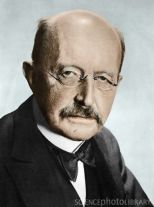 Max Planck was born in Kiel, Germany, on April 23, 1858. He was from an academic family, his father was a professor in law, his grandfather, and great-grandfather had been professors of theology at Göttingen. His father, Julius Wilhelm was Professor of Constitutional Law at the University of Kiel, and his mother’s name was Emma Patzig Planck. In 1867, he attended school in Munich, where his family had moved. He was not brilliant, but a good student, usually ranking between the third and eighth in his class.
Max Planck was born in Kiel, Germany, on April 23, 1858. He was from an academic family, his father was a professor in law, his grandfather, and great-grandfather had been professors of theology at Göttingen. His father, Julius Wilhelm was Professor of Constitutional Law at the University of Kiel, and his mother’s name was Emma Patzig Planck. In 1867, he attended school in Munich, where his family had moved. He was not brilliant, but a good student, usually ranking between the third and eighth in his class.
Planck studied at the Universities of Munich and Berlin, receiving his doctorate of philosophy in Munich in 1879. From 1880 to 1885, he was Privatdozent in Munich, until 1889 when he replaced Kirchoff as Professor at Berlin University. In 1894 the Prussian Academy of Sciences made him a member and he became permanent secretary in 1912. He remained there until his retirement in 1926. He gained membership to the Foreign Membership of the Royal Society in 1926, and was awarded the Society’s Copley Medal in 1928. He held the post of President of the Kaiser Wilhelm Society for the Promotion of Science until 1937.
In 1874, at 16, he entered the University of Munich. He considered the study of physics research with then Professor of Physics, Philipp von Jolly. He was cautioned that physics was practically a complete science with little further development prospects. Fortunately, he decided to study physics in spite of this caution. He wrote a thesis on the second law of thermodynamics and received his doctorate at the age of 21. Planck married twice. In 1885, he married a childhood friend, Marie Merck, who died in 1909. He then remarried Marie’s cousin, Marga von Hösslin.
Planck made the discovery of what is called Planck’s constant. It was the new constant of nature, the dimension of energy multiplied by time. It connected the quantum of energy with the frequency of light, which won him the Nobel prize in 1918. Although Planck resisted the idea of light in a vacuum propagating particles, the award host spoke differently at the ceremony. These particles are now called photons.
At the same time the problems of radiation process kept his attention and he showed that they were electromagnetic in nature. He then concentrated on the problem of energy distribution in the spectrum of full radiation. The experimental observations on wavelength distribution of energy emitted by a black body is widely known and studied today. Planck deduced the relationship between the energy and the frequency of radiation with the temperature function varying with classical physics predictions. In 1900, he announced his findings on the revolutionary idea of the relationship. Now called Planck’s constant, it states that the energy for a resonator could only take on discrete values, or quanta. Therefore, the energy for a resonator of frequency v is hv where h is a universal constant.
This was Planck’s most important work. It also marked a turning point for the history of physics. The importance of the discovery was not appreciated at first, but the evidence for its validity was soon understood. It accounted for many inconsistencies between observed phenomena and classical theory, such as the explanation of the photoelectric effect by Einstein.
This quantum theory work was published in the Annalen der Physik. The work summarized the two books Thermodynamik (Thermodynamics)in 1897 and Theorie der Wärmestrahlung (Theory of heat radiation) in 1906. Planck mastered every aspect of physics-thermodynamics and electrodynamics to relativity. He wrote large works on the philosophy of science.
Although Planck received the Nobel Prize for Physics in 1918, he took little participation in furthering the development of quantum theory. He left that task to Paul Dirac and others. He died in 1947, but he has left many memorable advances to the betterment of physics and mankind.
Source: light-science.com
